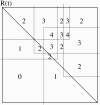On the maximal cliques in c-max-tolerance graphs and their application in clustering molecular sequences
- PMID: 16737529
- PMCID: PMC1524773
- DOI: 10.1186/1748-7188-1-9
On the maximal cliques in c-max-tolerance graphs and their application in clustering molecular sequences
Abstract
Given a set S of n locally aligned sequences, it is a needed prerequisite to partition it into groups of very similar sequences to facilitate subsequent computations, such as the generation of a phylogenetic tree. This article introduces a new method of clustering which partitions S into subsets such that the overlap of each pair of sequences within a subset is at least a given percentage c of the lengths of the two sequences. We show that this problem can be reduced to finding all maximal cliques in a special kind of max-tolerance graph which we call a c-max-tolerance graph. Previously we have shown that finding all maximal cliques in general max-tolerance graphs can be done efficiently in O(n3 + out). Here, using a new kind of sweep-line algorithm, we show that the restriction to c-max-tolerance graphs yields a better runtime of O(n2 log n + out). Furthermore, we present another algorithm which is much easier to implement, and though theoretically slower than the first one, is still running in polynomial time. We then experimentally analyze the number and structure of all maximal cliques in a c-max-tolerance graph, depending on the chosen c-value. We apply our simple algorithm to artificial and biological data and we show that this implementation is much faster than the well-known application Cliquer. By introducing a new heuristic that uses the set of all maximal cliques to partition S, we finally show that the computed partition gives a reasonable clustering for biological data sets.
Figures














References
-
- NCBI-Blast http://www.ncbi.nlm.nih.gov/BLAST/
-
- Golumbic MC, Trenk AN. Tolerance Graphs. Cambridge University Press; 2004.
-
- Fulkerson D, Gross O. Incidence matrices and interval graphs. Pacific J Math. 1965;15:835–855.
LinkOut - more resources
Full Text Sources
Miscellaneous

